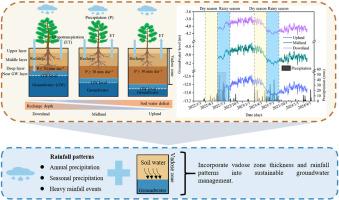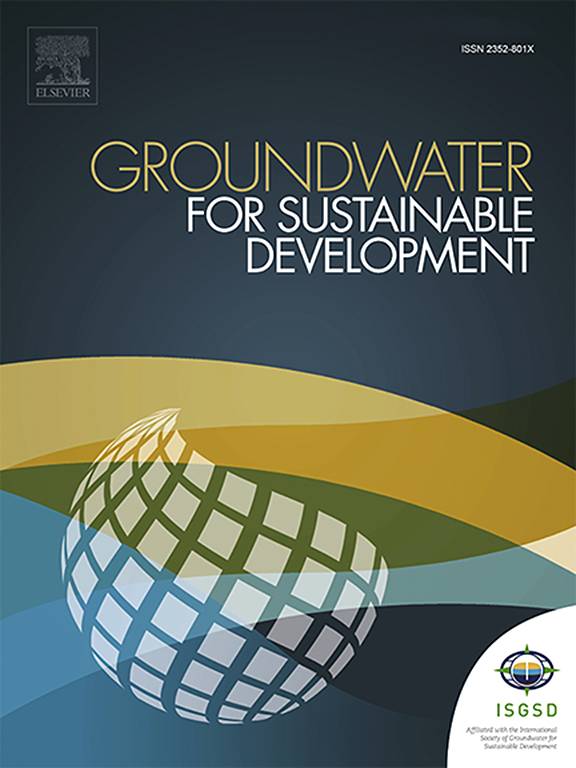Groundwater recharge responses to vadose zone thickness variation and rainfall patterns in arid Mongolian pine plantations
IF 4.9
Q2 ENGINEERING, ENVIRONMENTAL
引用次数: 0
Abstract
In arid and semi-arid regions, vadose zone thickness strongly influences precipitation infiltration and groundwater recharge, both increasingly affected by climate-driven shifts in rainfall patterns. However, its influence on soil water dynamics and groundwater recharge in plantation ecosystems remains inadequately understood. This study, conducted in the Mu Us Sandy Land of China, monitored stable isotopes, soil water, and groundwater levels over two years across three Mongolian pine plantations. These sites had different initial groundwater depths: 4 m (downland), 9 m (midland), and 13 m (upland). Key findings include: (1) Downland exhibited significantly greater mean soil water content (SWC) in the middle and deep soil layers than in the midland and upland (p < 0.05). (2) The soil desiccation index was higher in the midland and upland than in the downland. SWC increased in the upper and middle layers from the dry to the rainy season, but deep SWC decreased in the upland. (3) Rainfall events ≥20 mm day−1 replenish deep SWC in the downland, whereas ≥30 mm day−1 was required in the midland and upland. (4) In 2022, precipitation was more concentrated in ≥10 mm·day−1 events, totaling 311 mm (74.5 % of the annual total), and produced greater groundwater recharge than in 2023, when such events accounted for only 190 mm (56.5 %). These findings demonstrate that vadose zone thickness and rainfall intensity thresholds critically control groundwater recharge—a process further modulated by Mongolian pine plantations. Therefore, integrating these factors into management strategies is essential for sustainable groundwater conservation in arid regions.

干旱蒙松人工林地下水补给对渗透带厚度变化和降雨模式的响应
在干旱和半干旱地区,渗透带厚度强烈影响降水入渗和地下水补给,两者都日益受到气候驱动的降雨模式变化的影响。然而,其对人工林生态系统土壤水分动态和地下水补给的影响尚不清楚。这项研究在中国毛乌素沙地进行,在两年多的时间里监测了三个蒙古松林的稳定同位素、土壤水分和地下水水平。这些地点具有不同的初始地下水深度:4 m(洼地),9 m(中部)和13 m(高地)。主要发现包括:(1)中深土层的平均土壤含水量(SWC)显著高于中部和高地(p < 0.05)。(2)中部和高地土壤干旱化指数均高于洼地。旱季至雨季,上层和中层的SWC增加,而高地的深层SWC减少。(3)≥20 mm day−1的降雨事件补充了洼地深层SWC,而中部和高地则需要≥30 mm day−1的降雨事件。(4)与2023年相比,2022年降水更集中在≥10 mm·day−1事件中,降水总量为311 mm(占年总量的74.5%),地下水补给量更大,2023年降水总量仅为190 mm(56.5%)。这些发现表明,渗透带厚度和降雨强度阈值对地下水补给具有关键控制作用,而这一过程进一步受到蒙松人工林的调节。因此,将这些因素纳入管理战略对干旱区地下水的可持续保护至关重要。
本文章由计算机程序翻译,如有差异,请以英文原文为准。
求助全文
约1分钟内获得全文
求助全文
来源期刊

Groundwater for Sustainable Development
Social Sciences-Geography, Planning and Development
CiteScore
11.50
自引率
10.20%
发文量
152
期刊介绍:
Groundwater for Sustainable Development is directed to different stakeholders and professionals, including government and non-governmental organizations, international funding agencies, universities, public water institutions, public health and other public/private sector professionals, and other relevant institutions. It is aimed at professionals, academics and students in the fields of disciplines such as: groundwater and its connection to surface hydrology and environment, soil sciences, engineering, ecology, microbiology, atmospheric sciences, analytical chemistry, hydro-engineering, water technology, environmental ethics, economics, public health, policy, as well as social sciences, legal disciplines, or any other area connected with water issues. The objectives of this journal are to facilitate: • The improvement of effective and sustainable management of water resources across the globe. • The improvement of human access to groundwater resources in adequate quantity and good quality. • The meeting of the increasing demand for drinking and irrigation water needed for food security to contribute to a social and economically sound human development. • The creation of a global inter- and multidisciplinary platform and forum to improve our understanding of groundwater resources and to advocate their effective and sustainable management and protection against contamination. • Interdisciplinary information exchange and to stimulate scientific research in the fields of groundwater related sciences and social and health sciences required to achieve the United Nations Millennium Development Goals for sustainable development.
 求助内容:
求助内容: 应助结果提醒方式:
应助结果提醒方式:


